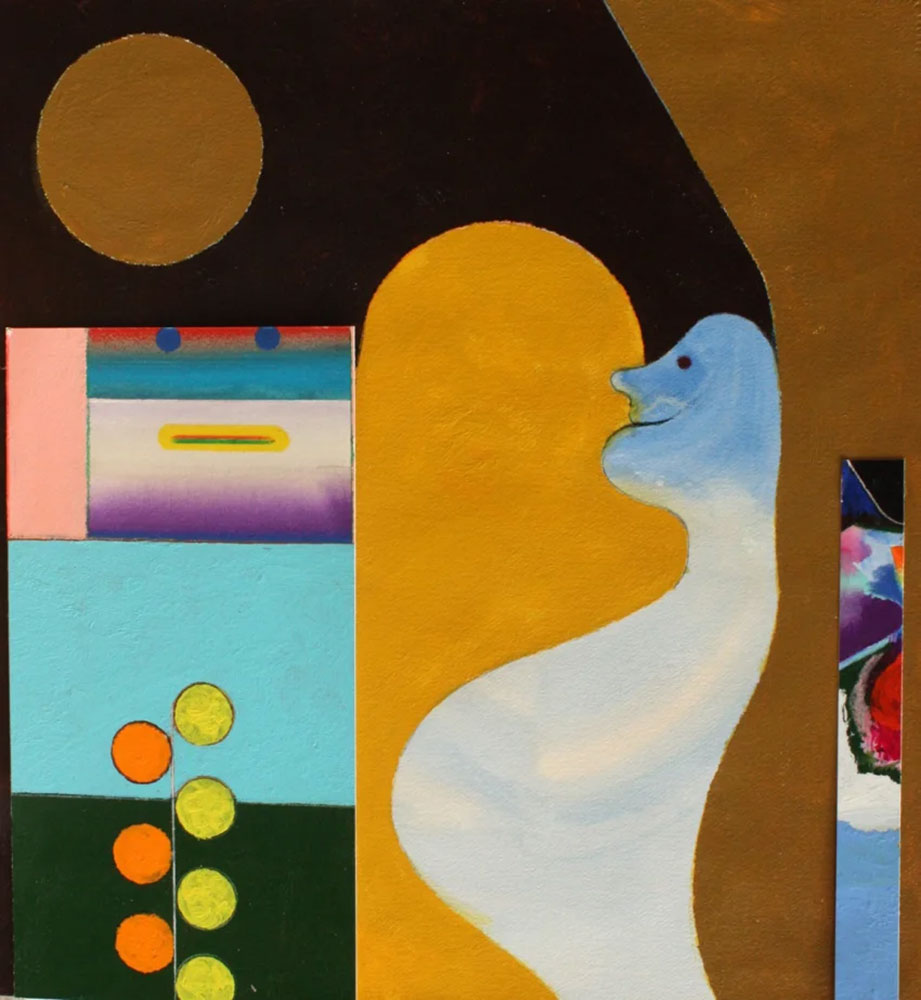PREVIEW: Eugene James Martin
 Eugene James ne Martin’s WORK is best known for his imaginative, complex mixed media synchronic and heterochronic collages on paper, his often gently humorous pencil and pen and ink drawings, and his paintings on paper and canvas that may incorporate whimsical allusions to animal, machine and structural imagery among areas of “pure”, constructed, biomorphic, or disciplined lyrical abstraction. Martin called many of his works straddling both abstraction and representation “satirical abstracts”.
Eugene James ne Martin’s WORK is best known for his imaginative, complex mixed media synchronic and heterochronic collages on paper, his often gently humorous pencil and pen and ink drawings, and his paintings on paper and canvas that may incorporate whimsical allusions to animal, machine and structural imagery among areas of “pure”, constructed, biomorphic, or disciplined lyrical abstraction. Martin called many of his works straddling both abstraction and representation “satirical abstracts”.
By Efi Michalarou
Photo: Galerie Nathalie Obadia
The exhibition with works from Eugene James Martin assembles a diverse range of artworks that defy easy classification. The juxtaposition of different mediums and the combinations of signifiers that point to—rather than represent—still lifes, flow like various forms of expression within the perfect unity of the completed works. Abstract forms, born from the artist’s imagination, seem to be the only common denominator in this ensemble of artworks, which spans from 1972 to 2003. Abstract art was Eugene James Martin’s best ally: it was a style that imposed ‘no restrictions and no rules’ on him; a style that allowed him to be completely free. This selection offers a glimpse into forty-two years of uninterrupted artistic endeavor, during which the artist remained guided solely by the principle of freedom until his passing in 2005. Beyond the vivid colors and the playful nature of the abstract forms, Eugene James Martin offers us, through these unique combinations, a distinctly personal perspective on the world. If freedom lies at the core of his artistic endeavors, it also serves as the defining principle of his life. Born in 1938 in the Capitol Hill district of Washington, D.C., Eugene James Martin displayed a compelling creative urge from an early age. For a short time, he even considered becoming a musician. His need for independence led him to the visual arts: as a performer in a band, he would never be free; as a painter, he would ‘only have to deal with himself and no one else’. In 1963, after studying art at the Corcoran School of the Arts and Design in Washington, D.C., he decided to become a full-time painter. When we examine the pieces in this exhibition, it comes as a surprise to discover that Eugene James Martin’s early work is marked by figurative imagery. His academic training initially led him to emulate Renaissance masters like Michelangelo. During the 1960s, influences from European modernists such as Pablo Picasso, Paul Klee and Joan Miró found their way into his paintings. From 1967 onwards, he abandoned figurative painting altogether, deeming it ‘too restrictive’. Works presented in this exhibition, spanning the period from 1972 to 2003, allow us to clearly appreciate the various shifts in techniques that have punctuated Eugene James Martin’s career. Two paper works from the “Oval Drawings “series open the exhibition: combinations of colorful shapes accumulate, appearing unstable, within an oval space, detaching themselves from the white background of the sheet. These early compositions heralded a completely new artistic approach at a time when Minimalism and Conceptual Art prevailed. Between 1976 and 1978, the artist subsequently began working on a series of small graphite pencil drawings: the contrast between full and empty forms and the humorously manipulated visual puns are reminiscent of the creations of surrealists such as Salvador Dalí. In the early 1980s, his explorations continued with a series produced entirely using bamboo reed pens and ink, featuring characters that are as funny as they are intriguing. Finally, at the beginning of the 1990s, the artist reintroduced vivid color into his work. His focus was particularly directed towards a category that comprised one-third of his entire artistic output: collages. He juxtaposed older works with more recent ones, and, driven by his unwavering commitment to maintain complete independence and creative freedom, relied exclusively on his own images in all of his collages. Although the various series exhibited present great variations, the style and spontaneity with which Eugene James Martin created his works remained unchanged. Ever independent and critical of the established artistic trends in the visual arts, his body of work—amounting to nearly five thousand works of art—bears an extremely personal and singular label. At a time when being an African-American artist in the U.S. implied confronting racist stereotypes and a predominantly white art world, Eugene James Martin claimed he never concerned himself with it, because ‘art came from the soul. It was him.’ In this way, he valued freedom above all else: throughout his life, the artist refused to compromise. It is in this unwavering approach that he found—along with his audience—the greatest liberation. The extreme skill and childlike purity of his compositions imbue his works with a limitless potential for interpretation, offering viewers endless possibilities for imagination.
Photo: Eugene James Martin, Haut-Brion 1929, 1997, Two acrylic 1990s paintings, signed 1997 and strips on rag paper, Courtesy Galerie Nathalie Obadia
Info: Galerie Nathalie Obadia, 8 rue Charles Decoster, Brussels, Belgium, Duration: 11/1-16/3/2024, Days & Hours: Tue-Sat 10:00-18:00, www.nathalieobadia.com/
